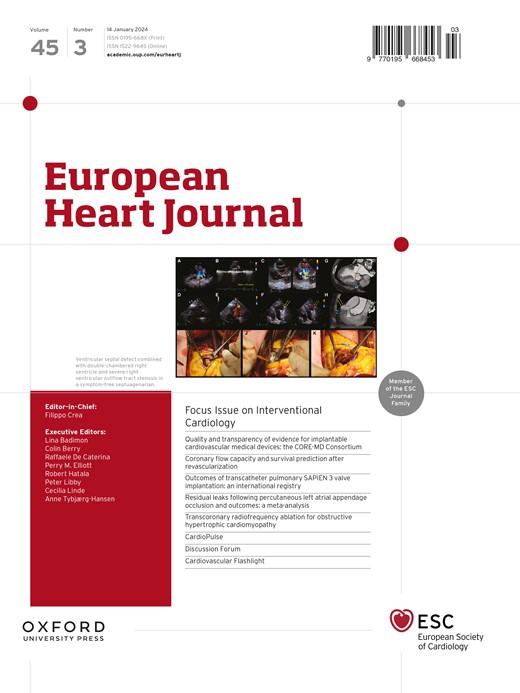Adult-onset type 1 diabetes: predictors of major cardiovascular events and mortality.
IF 37.6
1区 医学
Q1 CARDIAC & CARDIOVASCULAR SYSTEMS
引用次数: 0
Abstract
BACKGROUND AND AIMS The prognosis of adult-onset type 1 diabetes (T1D) and prognostic factors are sparsely investigated. This study assessed mortality, major adverse cardiovascular events (MACE), and prognostic factors in adult-onset T1D, particularly focusing on those diagnosed at age ≥40. METHODS Participants were people diagnosed with adult-onset T1D (n = 10 184) or type 2 diabetes (T2D, n = 375 523) in 2001-20 from the Swedish National Diabetes Register and 509 172 population controls from the Total Population Register, followed until 2022. Hazard ratios (HR) and population attributable risk fraction (PAR%) were estimated. RESULTS People with T1D had higher incidence of MACE (HR 1.30 [95% confidence interval 1.17, 1.45]), all-cause mortality (1.71 [1.60, 1.84]), and mortality from cardiovascular or non-cardiovascular diseases, cancer, or infection than population controls. They had lower MACE incidence (0.67 [0.60, 0.75]) and higher mortality from diabetic coma or ketoacidosis (7.04 [4.54, 10.9]) than people with T2D. Smoking (PAR% 10.7%) and glycated haemoglobin (HbA1c) ≥ 53 mmol/mol (10.4%) accounted for most deaths while overweight/obesity (19.8%), smoking (8.4%), and high HbA1c (8.8%) accounted for most MACE events in T1D. Results were similar for T1D diagnosed at age ≥40, although they had lower insulin pump use and higher HbA1c than people diagnosed earlier. CONCLUSIONS Adult-onset T1D carries excess risk of death and MACE compared with population controls but less MACE risk than T2D. Individuals diagnosed after age 40 had similar excess risk and poorer glycaemic control than those diagnosed earlier, underscoring the need for improved management. Key prognostic factors were smoking, poor glycaemic control, and overweight/obesity.成人发病1型糖尿病:主要心血管事件和死亡率的预测因子
背景与目的成人发病型1型糖尿病(T1D)的预后及预后因素研究较少。本研究评估了成人发病T1D的死亡率、主要不良心血管事件(MACE)和预后因素,特别关注那些诊断年龄≥40岁的患者。研究对象为2001-20年间瑞典国家糖尿病登记册中诊断为成人发病的T1D (n = 10 184)或2型糖尿病(n = 375 523)的患者,以及总人口登记册中诊断为人口对照的509 172人,随访至2022年。评估危险比(HR)和人群归因风险分数(PAR%)。结果T1D患者的MACE发生率(HR 1.30[95%可信区间1.17,1.45])、全因死亡率(HR 1.71[1.60, 1.84])、心血管或非心血管疾病、癌症、感染死亡率均高于人群对照组。MACE发生率(0.67[0.60,0.75])低于T2D患者,糖尿病昏迷或酮症酸中毒死亡率(7.04[4.54,10.9])高于T2D患者。吸烟(PAR% 10.7%)和糖化血红蛋白(HbA1c)≥53 mmol/mol(10.4%)占死亡人数最多,而超重/肥胖(19.8%)、吸烟(8.4%)和高HbA1c(8.8%)占T1D患者MACE事件的最多。年龄≥40岁时诊断为T1D的结果相似,尽管他们的胰岛素泵使用率较低,HbA1c高于早期诊断的患者。结论与人群对照相比,成年期起病的T1D具有更高的死亡和MACE风险,但MACE风险低于T2D。40岁以后确诊的患者与更早确诊的患者相比,有相似的额外风险和较差的血糖控制,这强调了改善管理的必要性。主要预后因素为吸烟、血糖控制不良和超重/肥胖。
本文章由计算机程序翻译,如有差异,请以英文原文为准。
求助全文
约1分钟内获得全文
求助全文
来源期刊

European Heart Journal
医学-心血管系统
CiteScore
39.30
自引率
6.90%
发文量
3942
审稿时长
1 months
期刊介绍:
The European Heart Journal is a renowned international journal that focuses on cardiovascular medicine. It is published weekly and is the official journal of the European Society of Cardiology. This peer-reviewed journal is committed to publishing high-quality clinical and scientific material pertaining to all aspects of cardiovascular medicine. It covers a diverse range of topics including research findings, technical evaluations, and reviews. Moreover, the journal serves as a platform for the exchange of information and discussions on various aspects of cardiovascular medicine, including educational matters.
In addition to original papers on cardiovascular medicine and surgery, the European Heart Journal also presents reviews, clinical perspectives, ESC Guidelines, and editorial articles that highlight recent advancements in cardiology. Additionally, the journal actively encourages readers to share their thoughts and opinions through correspondence.
 求助内容:
求助内容: 应助结果提醒方式:
应助结果提醒方式:


